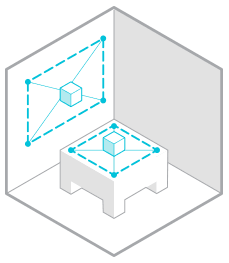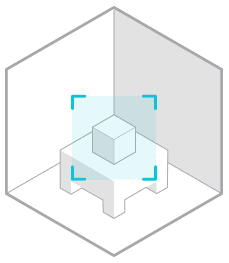WHAT WE OFFER
Plane detection software will use your mobile device camera to search for horizontal and vertical surfaces. This is done by finding visual cues within the camera view. These cues include contours or textures of objects to find different separated surfaces. When the surfaces are found, data from the camera and another sensors in your mobile device will be used to find the orientation of your view in 3d space. This enables the user to walk around in the physical space and see immediatly changes happening on the screen.
Plane detection: Horizontal & Vertical
Positioning virtual objects on physical horizontal and vertical surfaces

Plane detection is used to align information on your screen with horizontal and vertical surfaces in the physical world. This is done by finding visual cues within the camera view of your device of choice. The software will use these cues to generate separate flat horizontal and vertical surfaces. Using other sensors from your device the software will also find the orientation of your view in the 3d space. This opens the possibility to place information and 3d models onto the physical world. You can walk around and view this information from any angle.
Object recognition
Recognize physical objects and overlay virtual data

Object recognition is where software has predefined cues of physical objects from the physical world. These predefined cues are created or recorded using tools and create an unique fingerprint of the physical object. The AR software uses this information to recognizes physical objects through your devices camera view. When an object has been recognized the software can overlay information or trigger an event. This technology is often used on smaller physical objects and fingerprints can be created using a simple 3d scan.
3D model tracking
Track bigger physical objects using 3d modelss
3D model tracking is often used for medium to big sized physical objects which exceed the size to fit on an average desk. To be able to track a big physical object you need information that defines the shape of the object. This is done through carefully created 3D models which are often used for production in there industry. Using a 3D model as fingerprint the AR software compares physical objects in camera view with information of the 3d model. The detail of this 3d model has impact on the quality of the tracking.
Image tracking
Tracking physical 2d images
The simplest AR tracking solution and the most well known or used is image tracking. Using a predefined 2d image created in any 2d software an unique set of cues is created. The AR software will analyse your device camera view for anything which matches these cues. When a match is found the software can overlay any virtual object or information in the physical world or even trigger an event. This technology is often used in simple AR applications but this doesn’t mean you can’t create complex apps with it.
Light & Reflection estimation
Blend virtual objects in the physical world more naturally

One of the more sophisticated AR technologies is the light and reflection estimation. This technique is often complex and hard to master without the right knowledge. The AR software will analyze the camera view and based on the input it receives it will estimate lighting and reflections. With these estimations the software is able to apply more natural lighting and reflections to 3d models in your AR app. 3D models appear more realistic in the physical world and create a better AR experience for the user.